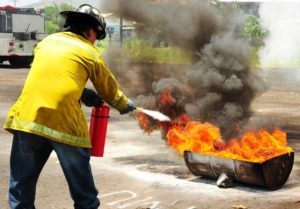 Purpose
Purpose
The fire fighting training provides participants with greater awareness and understanding of the dangers of fire and helps them to identify and reduce the risk that fire presents in the workplace. Participants will understand the actions to take in the event of discovering a fire or hearing the fire alarm sound in the workplace.
Fire Fighting Training is designed to equip learners with the knowledge and necessary skills to manage and extinguish a fire in the home or office environment, using a variety of techniques covered in the course.
Objectives
By the end of this fire fighting training the participants will have:
- A greater awareness of the dangers of fire and smoke
- Awareness of all fire safety measures in the workplace
- An understanding of their actions in the event of fire
- Confidence in identifying and operating fire fighting equipment
- Awareness of potential fire hazards in the workplace
Syllabus
Theory Fire Fighting
- Chemistry of Fire
- Extinguishing Methods
- Classes of Fire
- Types & Uses of Extinguishers
- Physical Properties of Matter
- Heat
- Thermal Expansion
- Chemistry
- Basic Hazards
- Basic Elements of Construction & Safety Practice
Practical
- Use of Fire Blanket
- Use of Various Fire Extinguishers
- Ventilation
- Smoke Room Experience
FIRE RESPONSE
Response to any fire scenario, regardless of the form of the response, should have these three basic priorities listed by importance:
1. Life Safety and Personal Protection. The most important thing to accomplish in any fire incident is to protect life and avoid injury. Property, product, processes and material can be replaced and rebuilt. Human life and health is most precious and cannot be replaced. If nothing else is accomplished in a fire incident other than the complete safety of all persons involved, then the first and the most important goal in a response to fire has been accomplished.
2. Incident Stabilization. Once the first priority has been accomplished, the second goal is to stabilize the incident – keep it from growing or getting worse. By stabilizing the incident and not allowing it to change, grow in intensity or grow in size, the incident cannot threaten more lives and property, even if the area or property involved becomes a total loss.
3. Property conservation. Only after item 1 and item 2 have been established, the focus may turn to extinguishing the fire quickly with the least amount of damage to the property involved. The role of portable extinguishers and pre-engineered systems in response to a fire incident has the same priorities listed above. Together with a fire plan, alarm notification, evacuation, quick and safe response, portable extinguishers and pre-engineered systems may be key factors in the outcome of any fire incident.
Fire Warden / Fire Marshall
Where in any installation, number of people are more or there is large crowd, the need for a Fire Warden or Fire Marshall was often felt. By a thumb rule, if the installation has more than 100 people, a designated fire warden should be there.
The role of the fire warden is to guide all personnel to the designated muster / safe area, guide them with putting on the PPE and communicate any instruction / command received from the emergency control room.
Course curriculum:
- The emergency response plan
- Location of PPE
- PPE to be worn
- Uses, care and limitation of PPE
- Assigned muster point
- Preparation of muster point
- Communications equipment
- Establishing communications
- Maintaining communications
- Head counting
- Control methods
- Communication methods
- Alternative muster points and routes
- Emergency control team commands
- Arrangements for devolved command
| Course | Fee INR | Duration | Course Timing | Date Commence | Remarks |
|---|---|---|---|---|---|
| Fire Fighting & Rescue | 7,000 | 1 Day | 10:00-18:00 | On Demand | Practical Exercises |
| Fire Warden | 7,000 | 1 Day | 10:00-18:00 | On Demand | Practical Exercises |
| Fire Emg Team Member | 7000 | 1 Day | 10:00-18:00 | On Demand | Practical Exercises |
